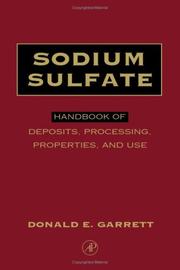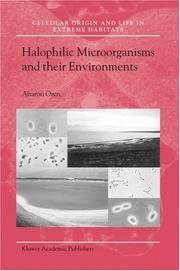| Listing 1 - 10 of 11 | << page >> |
Sort by
|
Book
Year: 1973 Publisher: Weinheim : Verlag Chemie,
Abstract | Keywords | Export | Availability | Bookmark
 Loading...
Loading...Choose an application
- Reference Manager
- EndNote
- RefWorks (Direct export to RefWorks)
SOLVENTS --- SODIUM COMPOUNDS --- SOLUTIONS (CHEMISTRY) --- PHYSICAL PROPERTY
Book
Year: 2014 Publisher: Washington, DC : United States International Trade Commission,
Abstract | Keywords | Export | Availability | Bookmark
 Loading...
Loading...Choose an application
- Reference Manager
- EndNote
- RefWorks (Direct export to RefWorks)
Nitrous acid. --- Sodium compounds. --- Sodium industry --- Dumping (International trade)
Book
ISBN: 9241504838 Year: 2012 Publisher: [Place of publication not identified] World Health Organization
Abstract | Keywords | Export | Availability | Bookmark
 Loading...
Loading...Choose an application
- Reference Manager
- EndNote
- RefWorks (Direct export to RefWorks)
Sodium, Dietary --- Sodium Chloride --- Sodium Compounds --- Inorganic Chemicals --- Chemicals and Drugs --- Sodium Chloride, Dietary --- Sodium, Dietary. --- Sodium Chloride. --- Sodium Compounds. --- Inorganic Chemicals. --- Sodium Chloride, Dietary.
Book
Year: 2012 Publisher: [Place of publication not identified] World Health Organization
Abstract | Keywords | Export | Availability | Bookmark
 Loading...
Loading...Choose an application
- Reference Manager
- EndNote
- RefWorks (Direct export to RefWorks)
Sodium, Dietary --- Sodium Chloride --- Sodium Compounds --- Inorganic Chemicals --- Sodium Chloride, Dietary --- Sodium, Dietary. --- Sodium Chloride. --- Sodium Compounds. --- Inorganic Chemicals. --- Sodium Chloride, Dietary.
Book
Year: 1890 Publisher: Washington, D.C. : Washington : Department of the Interior, United States Geological Survey, Government Printing Office.
Abstract | Keywords | Export | Availability | Bookmark
 Loading...
Loading...Choose an application
- Reference Manager
- EndNote
- RefWorks (Direct export to RefWorks)
Minerals --- Water --- Mineralogy. --- Nickel. --- Sodium compounds --- Crystallization, Water of. --- Alkalies --- Meteorites --- Sulfides --- Analysis. --- California --- Colorado. --- Nevada. --- Wyoming.

ISBN: 1281027170 9786611027179 0080517331 0122761510 9780080517339 9780122761515 Year: 2001 Publisher: San Diego : Academic Press,
Abstract | Keywords | Export | Availability | Bookmark
 Loading...
Loading...Choose an application
- Reference Manager
- EndNote
- RefWorks (Direct export to RefWorks)
Sodium Sulfate: Handbook of Deposits, Processing, Properties, and Use will be the authoritative and up-to-date distillation of all that is known about naturally occurring sodium sulfate, detailed information on formation, worldwide deposits, processing technologies, and usage over time. Garrett provides a comprehensive overview of sodium sulfate from deposit formation, through processing technologies and usage.Garrett's reference addresses the need for a comprehensive handbook on this industrial mineral. Dr. Garrett's unique chemical engineering background and flair for his
Sodium sulfate. --- Sodium salts. --- Salts --- Sodium compounds --- Anhydrous sodium sulfate --- Disodium sulfate --- Glauber's salt --- Mirabilite --- Niter cake --- Salt cake --- Sodium bisulfate --- Sodium sulphate --- Sulfuric acid disodium salt --- Sodium salts --- Sulfates
Book
ISBN: 9400798830 9400755384 9400755392 1283936216 Year: 2012 Publisher: New York : Springer,
Abstract | Keywords | Export | Availability | Bookmark
 Loading...
Loading...Choose an application
- Reference Manager
- EndNote
- RefWorks (Direct export to RefWorks)
Saline environments are one of the most plentiful and interesting types of habitats on Earth and are often considered as models for potential life on other planets or moons. The hypersaline playas, sabkhas, salterns, lakes, soils and even crystals often contain biomass that is far in excess of what might be predicted from the environmental conditions alone. The populations become so dense they color the brines and have been noticed by humanity since 2500 BC. In addition much of planet Earth is underlain by vast ancient salt deposits that may be thousands of meters thick and stretch for many kilometers. Even deep within the Earth’s crust there are vast reservoirs of saline water all of which contain salt loving microbes. These are not however simple terminal ecosystems. These saline habitats literally team with a complex web of life containing large populations of salt loving bacteria, archaea, algae, viruses and even fungi. Halophilic microorganisms are one of the more fascinating microbial groups known today. Their ability to exist in exceptionally high salt (as NaCl) brines, soils and even in ancient halite provides a wide array of areas for physiological, ecological and molecular studies. Whenever media reports present something on salt loving microbes there is intense public interest and fascination. The scientists that begin to study halophiles never stop. This book is an update of one originally published in 1992. Many of the topics covered are the same but others are new and reflect more modern approaches. This book is not a series of reviews of topics. It is more than that.
Adaptation, Physiological. --- Halobacteriales -- physiology. --- Halomonadaceae -- physiology. --- Halophilic microorganisms. --- Halophilic microorganisms --- Environmental Microbiology --- Chlorides --- Biological Science Disciplines --- Sodium Compounds --- Organisms --- Microbiology --- Public Health --- Inorganic Chemicals --- Natural Science Disciplines --- Hydrochloric Acid --- Chemicals and Drugs --- Chlorine Compounds --- Disciplines and Occupations --- Biology --- Environment and Public Health --- Health Care --- Water Microbiology --- Physiology --- Sodium Chloride --- Archaea --- Health & Biological Sciences --- Microbiology & Immunology --- Micro-organisms, Halophilic --- Medicine. --- Life sciences. --- Microbial ecology. --- Microbiology. --- Biomedicine. --- Biomedicine general. --- Life Sciences, general. --- Microbial Ecology. --- Halophilic organisms --- Microorganisms --- Environmental microbiology --- Ecology --- Microbial biology --- Biosciences --- Sciences, Life --- Science --- Clinical sciences --- Medical profession --- Human biology --- Life sciences --- Medical sciences --- Pathology --- Physicians --- Health Workforce --- Biomedicine, general.
Book
ISBN: 0309282950 0309282969 0309282985 Year: 2013 Publisher: Washington, District of Columbia : The National Academies Press,
Abstract | Keywords | Export | Availability | Bookmark
 Loading...
Loading...Choose an application
- Reference Manager
- EndNote
- RefWorks (Direct export to RefWorks)
Food -- Sodium content -- United States. --- Nutrition policy -- United States. --- Sodium in the body -- United States. --- Food --- Sodium in the body --- Nutrition policy --- Diet --- Sodium Compounds --- Diet Therapy --- Health Occupations --- Preventive Health Services --- Public Health Practice --- Nutritional Physiological Phenomena --- Public Health --- Health Services --- Disciplines and Occupations --- Inorganic Chemicals --- Nutrition Therapy --- Health Care Facilities, Manpower, and Services --- Therapeutics --- Physiological Phenomena --- Environment and Public Health --- Chemicals and Drugs --- Analytical, Diagnostic and Therapeutic Techniques and Equipment --- Health Care --- Phenomena and Processes --- Evidence-Based Practice --- Primary Prevention --- Diet, Sodium-Restricted --- Sodium, Dietary --- Health & Biological Sciences --- Diet & Clinical Nutrition --- Sodium content --- United States.
Book
ISBN: 0309148057 9786612885631 0309148065 1282885634 9780309148054 9780309148061 0309155886 9781282885639 6612885637 9780309155885 Year: 2010 Publisher: Washington, DC : National Academies Press,
Abstract | Keywords | Export | Availability | Bookmark
 Loading...
Loading...Choose an application
- Reference Manager
- EndNote
- RefWorks (Direct export to RefWorks)
"Reducing the intake of sodium is an important public health goal for Americans. Since the 1970s, an array of public health interventions and national dietary guidelines has sought to reduce sodium intake. However, the U.S. population still consumes more sodium than is recommended, placing individuals at risk for diseases related to elevated blood pressure. Strategies to Reduce Sodium Intake in the United States evaluates and makes recommendations about strategies that could be implemented to reduce dietary sodium intake to levels recommended by the Dietary Guidelines for Americans. The book reviews past and ongoing efforts to reduce the sodium content of the food supply and to motivate consumers to change behavior. Based on past lessons learned, the book makes recommendations for future initiatives. It is an excellent resource for federal and state public health officials, the processed food and food service industries, health care professionals, consumer advocacy groups, and academic researchers."--Publisher's description.
Sodium, Dietary - United States. --- Nutrition policy --- Sodium in the body --- Salt-free diet --- Food --- Health Care Facilities, Manpower, and Services --- Nutritional Physiological Phenomena --- North America --- Sodium Compounds --- Public Policy --- Investigative Techniques --- Preventive Health Services --- Health Services --- Inorganic Chemicals --- Social Control Policies --- Physiological Phenomena --- Health Care --- Analytical, Diagnostic and Therapeutic Techniques and Equipment --- Americas --- Diet --- United States --- Sodium, Dietary --- Health Policy --- Health Promotion --- Social Control, Formal --- Policy --- Phenomena and Processes --- Chemicals and Drugs --- Geographic Locations --- Sociology --- Social Sciences --- Health Care Economics and Organizations --- Geographicals --- Anthropology, Education, Sociology and Social Phenomena --- Health & Biological Sciences --- Diet & Clinical Nutrition --- Sodium content --- Foods --- Low-salt diet --- Low sodium diet --- Sodium-restricted diet --- Dinners and dining --- Home economics --- Table --- Cooking --- Dietaries --- Gastronomy --- Nutrition --- Cooking for the sick --- Diet in disease --- Heart --- Body composition --- Diseases --- Diet therapy --- Primitive societies

ISBN: 1280551097 9786610551095 0306480530 1402008295 Year: 2002 Publisher: Dordrecht, the Netherlands ; Boston, Massachusetts : Kluwer Academic Publishers,
Abstract | Keywords | Export | Availability | Bookmark
 Loading...
Loading...Choose an application
- Reference Manager
- EndNote
- RefWorks (Direct export to RefWorks)
"This water" he told me, "runs out to the eastern region, and flows into the Arabah; and when it comes into the sea, into the sea of foul waters [i. e. , the Dead Sea], the water will become wholesome. Every living creature that swarms will be able to live wherever this stream goes; the fish will be very abundant once these waters have reached there. It will be wholesome, and everything will live wherever this stream goes. Fishermen shall stand beside it all the way from En-gedi to En-eglaim; it shall be a place for drying nets; and the fish will be of various kinds [and] most plentiful, like the fish of the Great Sea. " Ezekiel’s prophecy (Ezekiel 47: 8-10) for revival and purification of the Dead Sea waters This new book on "Halophilic Microorganisms and their Environments" is the fifth volume in the COLE series (Cellular Origin and Life in Extreme Habitats (see: http://www. wkap. nl/prod/s/COLE). In the previous books we covered aspects of enigmatic microorganisms, microbial diversity, astrobiology, and symbiosis, so this book on halophilic microbes adds a fitting link to the rest of series' books. Since ancient times hypersaline habitats have been considered extreme environments, and some were thought not to sustain life at all. Yet, every organism requires salt for its existence. Salty places have been compared to an environment of extinction (e. g. , the Dead Sea).
Organisms --- Adaptation, Biological --- Environmental Microbiology --- Sodium Compounds --- Physiological Processes --- Euryarchaeota --- Chlorides --- Hydrochloric Acid --- Public Health --- Physiological Phenomena --- Microbiology --- Biological Processes --- Archaea --- Inorganic Chemicals --- Chlorine Compounds --- Chemicals and Drugs --- Biology --- Phenomena and Processes --- Biological Phenomena --- Environment and Public Health --- Biological Science Disciplines --- Health Care --- Natural Science Disciplines --- Disciplines and Occupations --- Water Microbiology --- Sodium Chloride --- Adaptation, Physiological --- Bacteria --- Halobacteriales --- Health & Biological Sciences --- Microbiology & Immunology --- Microbial ecology. --- Nature conservation. --- Geochemistry. --- Aquatic ecology . --- Biochemistry. --- Microbial Ecology. --- Nature Conservation. --- Freshwater & Marine Ecology. --- Biochemistry, general. --- Biological chemistry --- Chemical composition of organisms --- Physiological chemistry --- Chemistry --- Medical sciences --- Aquatic biology --- Ecology --- Chemical composition of the earth --- Chemical geology --- Geological chemistry --- Geology, Chemical --- Earth sciences --- Conservation of nature --- Nature --- Nature protection --- Protection of nature --- Conservation of natural resources --- Applied ecology --- Conservation biology --- Endangered ecosystems --- Natural areas --- Environmental microbiology --- Microorganisms --- Composition --- Conservation --- Halophilic microorganisms. --- Micro-organisms, Halophilic --- Halophilic organisms
| Listing 1 - 10 of 11 | << page >> |
Sort by
|

 Search
Search Feedback
Feedback About UniCat
About UniCat  Help
Help News
News